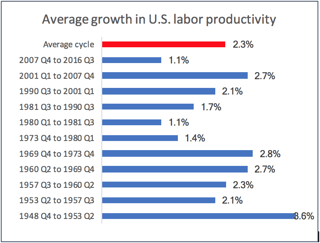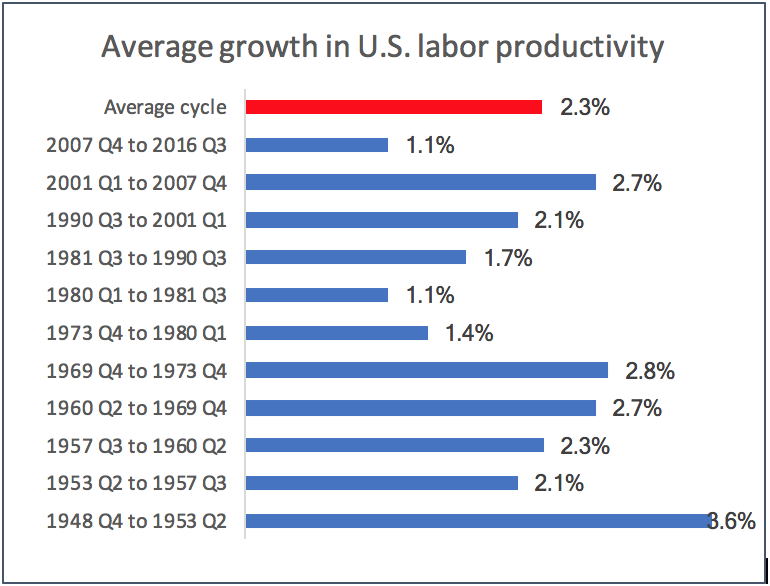With all of the investment in technology, why is productivity lagging?
The following chart from the U.S. Bureau of Labor Statistics caught my eye:

Let’s spend a few minutes and dive into these numbers a bit.
What the chart says is that productivity growth over the past decade – a period that certainly has not lacked investment in technology – is the lowest since 1948.
Wait, it gets worse.
If you take out the first two years of the past decade – the years of the financial crash – the average annual growth rate is about 0.6%: “Nearly half of the overall productivity growth during the current business cycle occurred the period from the fourth quarter of 2008 to the fourth quarter of 2009.”
What on earth is going on here? Here’s my take.
During the 1990s and 2000s, we focused on automating core, mission-critical, and document-intensive processes. AIIM calls this the era of “Systems of Engagement.” Like the interstate highway systems of a prior generation, these Systems of Record paved the way for an enormous economic expansion -- and huge productivity improvements. This first wave of automation started with large companies, and over time, many of the technologies that were originally the exclusive domain of large companies began to spread to small and mid-sized companies through SaaS applications.
But in the current second wave of automation (focused on knowledge workers) I fear that the technology “toolkit” we provide to these knowledge workers – and particularly how the tools in this toolkit are connected and integrated -- has not kept pace with changes in where and how they work.
At best, the typical technology experience for most knowledge workers is a collection of disconnected platforms and applications. We expect knowledge workers to play the role of human system integrators, copying and pasting information across systems – if they can find the information they need at all. They struggle with trying to port technology interfaces built for desktop PCs during the era of Systems of Record to mobile devices. Deployment of single process SaaS applications has been great in the short term, but I fear is exacerbating the information silo problem that confounds most knowledge workers. Most knowledge workers suffer from a two-screen schizophrenia in which they are constantly switching back and forth between applications.
Of course, the ultimate impact of all of this is reflected in stagnant compensation levels – and burned out knowledge workers. As Mr. Sprague from the BLS notes, “The historically low rate of labor productivity growth during the current business cycle has limited gains in living standards for Americans during this period. U.S. workers have had to work more hours to produce the current supply of goods and services that would have been the case with higher productivity growth.”
I think we are on the cusp of a massive spurt in productivity if -- and it’s a big if for many organizations – we can refocus our technology investments around how and where knowledge workers work. We need to focus on modern user interfaces. We need to facilitate collaboration across borders and time zones. At long last, we need to get rid of all of that paper. We need to relentlessly focus on seamlessly connecting people and processes with the information and documents upon which they depend.
Committing to a cloud-centric, flexible and agile approach to where and how employees work is not just good for employees. A results-driven rather than attendance-driven strategy is good for the business as well, whatever your degree of “virtualness.” And a modern information and process infrastructure is critical to making it all work.



